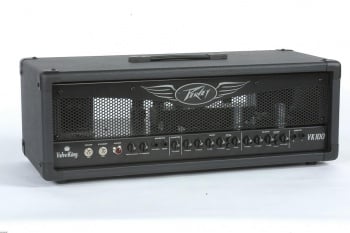Peavey Valveking 100 Head Review
Contents |
General Information
Original author: Mudbone
Weapon: Guitar Amp
Make: Peavey
Model: Valveking 100
Price: $???
Introduction
Can it play metal? This has got to be the number one question asked about this amp. If you're a metal head in the market for an entry level full powered tube head, you should be asking yourself this question as well. I'll answer this question in just a moment, but first lets go over the features.
Features
- 100 watts
- 4 Ruby 6L6GCM-STR Power Tubes
- 3 12AX7 JJ Preamp Tubes
- 2 Channels, Clean and Lead - Passive EQ on Both
- Presence and Resonance controls
- Gain Boost
- Volume Boost
- Bright Switch on Clean Channel
- High and Low Gain Inputs
- Master Spring Reverb
- Buffered Effects loop
- Ohm Selector - 4, 8, 16
- Patented Texture Knob - Sweep Between Simulated Class "A" and Full Power Class "A/B"
Tubes
This particular amp came equipped with Ruby Tubes 6L6GCM-STR power tubes and JJ 12AX7 preamp tubes. For those who would like to know, "STR" stands for "Special Tube Request". The company Ruby Tubes don't actually manufacture any of their tubes, but instead put their name on tubes that are manufactured for them by other tube manufacturers. The STR tubes in this amp were most likely designed by Ruby Tubes according to specifications provided by Peavey. So why is this important to know? When its time to replace the power tubes, unless you get these same exact tubes, you won't be able to get this amp to sound exactly the same as when it came from the factory. In fact, I don't know where you'll be able to find these same exact tubes on the after market. Personally, I like to try new things all the times, so I don't feel like its an issue. But some people insist on having an amp remain completely stock. The preamp tubes are JJ's, so those can be found all over the internet.
Foot Switch... Or lack thereof
The foot switch was not included with this amp, most likely so it can meet a certain price point. They go for around $40 for an original Peavey foot switch, but you can find aftermarket ones for around $25 on eBay. But, keep in mind the cheap one on eBay doesn't have any lights and you will need a stereo cable as well. The aftermarket one is made of steel, while the Peavey one is made from plastic. If you're concerned about the plastic Peavey footswitch, fear not for they are quite durable. I have one for my Ultra Plus head that is from the 90's and it is still kicking. The foot switch has a channel select and a boost switch, which can be used on either the volume boost or the gain boost, but not both.
Build Quality
Peavey amps have a legendary reputation for being extremely rugged. Many amp techs claim that Peavey and Mesa are the most durable amps out there. However, this reputation is from Peavey's American line of amps, so how does this Chinese manufactured amp stack up? In my opinion, it seems like it is built just as rugged as the American line of amps. The quality of materials and fit and finish is great. I must say though, the amp does look very bland, and thats what gives it its budget look. The faceplate and knobs aren't as nice as on the Ultra Plus I have sitting on top of it. But I'm more concerned with how it performs over the long haul, and this is one of the main reasons I chose this amp over the competition.
Texture Control Knob
This knob changes the amp from simulated class "A" to full power class "A/B". Its located on the back of the amp, which I think is kinda silly, because its pretty useful, and would be much more useful if it was on the front. I think if Peavey ever does a redesign of this amp they should move the effects loop from front panel to the back and bring this knob to the front.
So what exactly does it do? Well I wish I could tell you the difference between class "A" and class "A/B" in plain English, but I still don't fully understand it myself. When I complete my electrical engineering degree in a couple of years I'll come back and explain it, but until then, I'll tell you what it does in terms of practical application and what my ears tell me it sounds like.
When the knob is swept all the way to right to class "A/B" the amp is in full power mode, and this provides a more modern sound. The amp gets louder and the bottom end gets tighter. In this mode the amp is running at a full 100 watts. If you want maximum headroom and maximum flexibility and versatility, this is where you want it. When I play with a band, this is where I usually keep it.
When the knob is swept all the way to the left to class "A" the amps power drops down to almost 40 watts. The tone gets a little looser but also seem to get a little richer. When I'm playing at home at low volumes I usually have it in this position, it just seems to sound sweeter and more manageable than when in class "A/B". However, if you like to play palm muted pedal low E notes, you may want to put the knob to "A/B". Cleans sound more textured and richer when the knob is in class "A".






